Role Queen regnant Name Maria of | Siblings Pedro II of Brazil | |
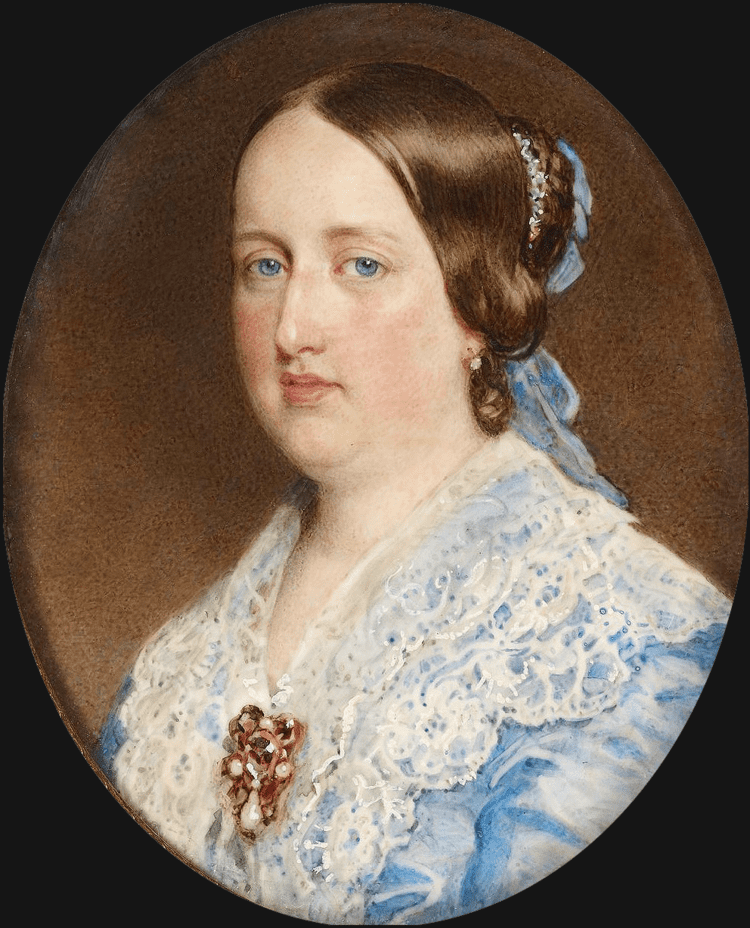 | ||
1st reign 2 May 1826 – 23 June 1828 Regents SeeInfanta Isabel Maria(2 May 1826 – 26 February 1828)Infante Miguel(26 February – 23 June 1828 ) 2nd reign 26 May 1834 – 15 November 1853 Died November 15, 1853, Lisbon, Portugal Spouse Ferdinand II of Portugal (m. 1836–1853), Auguste de Beauharnais (m. 1834–1835) Children Pedro V of Portugal, Luis I of Portugal Parents Maria Leopoldina of Austria, Pedro I of Brazil Similar People | ||
Dona Maria II (4 April 1819 – 15 November 1853) "the Educator" (Portuguese: "a Educadora") or "the Good Mother" (Portuguese: "a Boa Mãe"), was Queen regnant of the Kingdom of Portugal and the Algarves from 1826 to 1828, and again from 1834 to 1853. She was a member of the House of Braganza.
Contents
- Early life
- Succession crisis
- Reign
- Marriages and issue
- Titles and styles
- National honours
- Foreign
- References

Early life
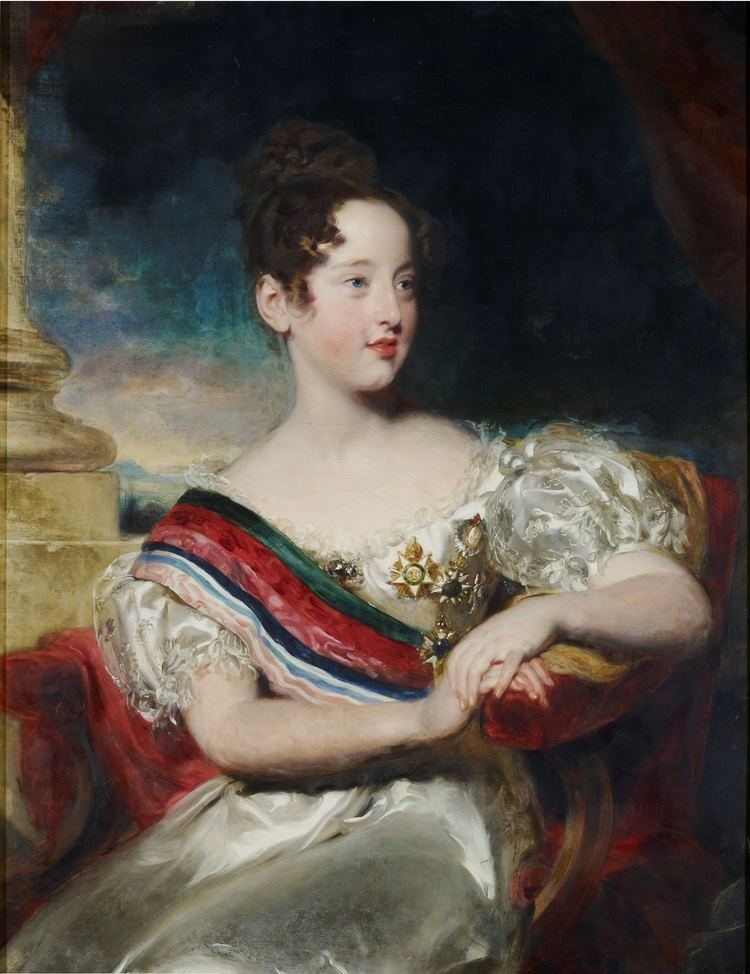
Born Maria da Glória Joana Carlota Leopoldina da Cruz Francisca Xavier de Paula Isidora Micaela Gabriela Rafaela Gonzaga in Rio de Janeiro, she was the eldest daughter of the future King of Portugal and first Emperor of Brazil, Pedro IV and I, and his first wife Maria Leopoldina, Archduchess of Austria, herself a daughter of Emperor Francis II. Born in Brazil, Maria was the only European monarch to have been born outside of Europe, though she was still born in Portuguese territory.
Succession crisis

The death of Maria's grandfather, King João VI, in March 1826 sparked a succession crisis in Portugal. The king had a male heir, Pedro, but Pedro had proclaimed the independence of Brazil in 1822 with himself as Emperor. The late king also had a younger son, Miguel, but he was exiled to Austria after leading a number of revolutions against his father and his liberal regime.
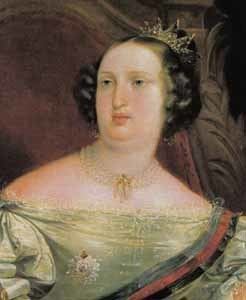
Before his death, the king had nominated his favourite daughter, Isabel Maria, to serve as regent until "the legitimate heir returned to the kingdom" — but he had failed to specify which of his sons was the legitimate heir: Pedro, the liberal Emperor of Brazil, or Miguel, the absolutist exiled prince.

Most people considered Pedro to be the legitimate heir, but Brazil did not want him to unite Portugal and Brazil's thrones again. Aware that his brother's supporters were ready to bring Miguel back and put him on the throne, Pedro decided for a more consensual option: he would renounce his claim to the Portuguese throne in favour of his daughter Maria (who was only seven years old), and that she was to marry her uncle Miguel, who would accept the liberal constitution and act as a regent until his niece reached majority.
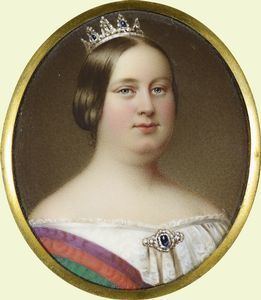
Miguel pretended to accept, but upon his arrival in Portugal he immediately deposed Maria and proclaimed himself king, abrogating the liberal constitution in the process. During his reign of terror, Maria traveled to many European courts, including her maternal grandfather's in Vienna, as well as London and Paris.
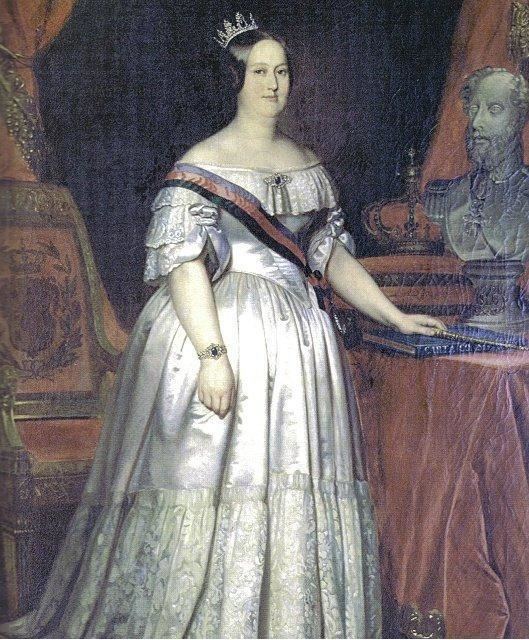
Pedro abdicated the Brazilian throne in 1831 in favour of his son, Maria's younger brother Pedro II, and joined the forces loyal to Maria in the Azores in their war against Miguel, forcing him to abdicate in 1834. Maria was thereupon restored to the throne, and obtained an annulment of her betrothal.

On 7 February 1833, in order to protect the Queen, the 2nd Lancers Regiment was created, first known as the Regimento de Lanceiros da Rainha (Queen's Lancers Regiment), with the motto Morte ou Glória, "Death or Glory" (the same as the 17th Lancers, since Lt. Col. Sir Anthony Bacon was its first commander), a fortunate coincidence since the queen's name was Maria da Glória.
Maria II was heir presumptive to her brother Pedro II as Princess Imperial, until her exclusion from the Brazilian line of succession by law no. 91 of 30 October 1835.
Reign
Maria married Auguste, Duke of Leuchtenberg, son of Eugène de Beauharnais, and grandson of Empress Josephine on 26 January 1835, at the age of fifteen. However, he died only two months later, on 28 March 1835.
On 1 January 1836, she married the cultured and able Prince Ferdinand of Saxe-Coburg and Gotha. In accordance with Portuguese law, Ferdinand received the title of king upon the birth of their first child and heir, Peter.
In 1842, Pope Gregory XVI presented Maria with a Golden Rose.
Maria's reign saw a revolutionary insurrection on 16 May 1846, but this was crushed by royalist troops on 22 February 1847, and Portugal otherwise avoided the European Revolution of 1848. Maria's reign was also notable for a public health act aimed at curbing the spread of cholera throughout the country. She also pursued policies aimed at raising the levels of education throughout the country.
After constant pregnancies and births, doctors warned Maria of the dangers of giving birth nearly every year. However, she ignored the risks that had killed her mother, who had died of complications following a miscarriage after multiple births; "If I die," she said, "I die at my post." In 1853 she died in Lisbon giving birth to her eleventh child, Infante Eugénio, who himself died not long after.
Queen Maria II is remembered as a good mother and a kind person who always acted according to her convictions in her attempt to help her country. She was later given the nickname "The Good Mother."
Marriages and issue
Maria first married Auguste Charles, 2nd Duke of Leuchtenberg, son of Eugène de Beauharnais, grandson of Empress Josephine, who died soon after arriving in Portugal. She then married Ferdinand of Saxe-Coburg and Gotha, son of Prince Ferdinand Georg August of Saxe-Coburg and Gotha and his wife Princess Maria Antonia Koháry de Csábrág.
